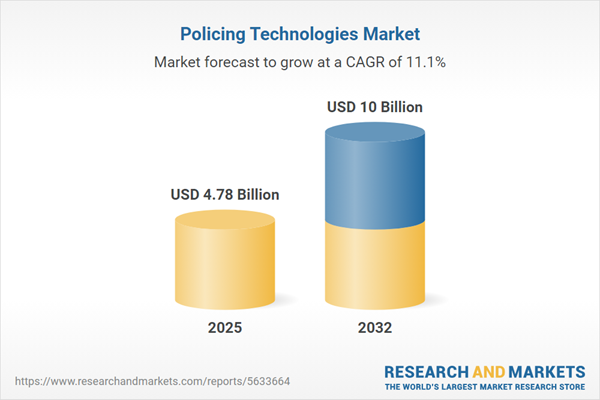Speak directly to the analyst to clarify any post sales queries you may have.
The policing technologies market is transforming law enforcement operations as agencies globally invest in advanced digital tools to address complex security challenges. Senior decision-makers now prioritize scalable solutions that enhance visibility, coordination, and trust in public safety systems.
Market Snapshot: Policing Technologies Market Growth and Outlook
The Policing Technologies Market expanded from USD 4.30 billion in 2024 to USD 4.78 billion in 2025, with projections pointing to continued growth at a CAGR of 11.12% to reach USD 10.00 billion by 2032.
This momentum reflects a global push among agencies to streamline patrol and emergency response, improve data-driven crime prevention, and deploy interoperable technologies that adapt rapidly to shifting resource requirements and legislative frameworks. There is heightened demand for integrated platforms supporting both command-center oversight and field-level actions.Scope & Segmentation of the Policing Technologies Market
This report presents a multi-dimensional analysis of the policing technologies market, equipping stakeholders with insights into evolving product lines, applications, and regional trends:
- Product Types: Includes a broad suite of tools: cameras for surveillance and incident documentation; communication equipment designed for uninterrupted networking; robust sensors; consulting and maintenance services; and system integration for maximizing solution effectiveness. Also covers advanced software for computer-aided dispatch, analytical crime review, and comprehensive video management.
- Applications: Ranges from biometric-enhanced border control and vehicle scanning, to optimized emergency response leveraging dispatch solutions and real-time reporting. Predictive policing is emphasized through analytics and workflow management, alongside continual upgrades in surveillance capabilities and adaptable traffic management systems.
- Deployment Modes: Encompasses flexible cloud models—both private and public—alongside on-premise solutions, including edge deployments and enterprise data centers, supporting diverse agency preferences and regional compliance.
- End Users: Federal agencies requiring national-scale integration, municipal entities optimizing city-wide operations, and private security firms seeking technology-driven competitive advantages.
- Technologies: Covers artificial intelligence and machine learning to automate insights; facial and fingerprint biometrics for secure identification; IoT networks for connected operations; robotics patrol units; and unmanned aerial vehicles augmenting situational awareness.
- Regions Covered: Comprehensive analysis spans the Americas, Europe, Middle East & Africa, and Asia-Pacific, providing granular perspectives across established, emerging, and high-growth regulatory environments.
- Leading Companies: Key market participants include Motorola Solutions, Axon Enterprise, Palantir Technologies, NICE Ltd., Verint Systems, L3Harris Technologies, NEC Corporation, Thales Group, Hanwha Systems, and Huawei Technologies.
Key Takeaways for Decision-Makers
- Adoption of digital ecosystems and cloud-native platforms is advancing strategic integration, enabling agencies to unify legacy infrastructures with advanced applications for more coherent and secure data flow.
- AI and IoT are reshaping operational approaches, refining patrol deployment, and elevating situational awareness, thus facilitating more targeted field responses and supporting preemptive security strategies.
- Compliance considerations, including data privacy, anti-bias mechanisms, and multi-jurisdictional compatibility, are central to procurement, influencing both vendor selection and technology implementation timelines.
- Regional market characteristics guide adoption strategies: North America emphasizes interoperability and privacy, Europe concentrates on compliance with strict data protections, Asia-Pacific leverages digital mobility, and Africa values solutions scalable for broad geographic coverage.
- Modular technology offerings are being prioritized, providing agencies with adaptability and reducing infrastructure overhaul needs while supporting a broad range of operational requirements.
- Public-private collaboration continues to foster agile innovation, with enhanced civilian engagement tools and interoperability enabling multi-agency coordination and rapid response to evolving threats.
Tariff Impact on Supply Chains and Procurement
Recent tariff changes in the United States have raised procurement and component costs. Agencies are responding by renegotiating terms with vendors, pursuing domestic partnerships, and shifting toward modular designs that streamline system upgrades. These adjustments strengthen procurement discipline and diversify supply chains, supporting local manufacturing and adaptive sourcing as priorities.
Methodology & Data Sources
This research draws on in-depth interviews with senior law enforcement and technology leaders, detailed analysis of regulatory documents and patent information, and multi-source data validation across proprietary and open intelligence feeds. Peer-reviewed scenarios provide a balanced mix of qualitative and quantitative perspectives.
Why This Report Matters for Policing Technology Stakeholders
- Strategic market segmentation supports targeted investment and portfolio planning, reducing compliance risk and optimizing operational effectiveness within fluctuating regulatory environments.
- In-depth intelligence enables agencies and suppliers to benchmark their innovation efforts and stay ahead of key deployment trends worldwide and regionally.
Conclusion
This report equips security and law enforcement leaders to align technology investment with changing operational and regulatory imperatives, unlocking opportunities for more resilient, effective, and transparent policing solutions.
Additional Product Information:
- Purchase of this report includes 1 year online access with quarterly updates.
- This report can be updated on request. Please contact our Customer Experience team using the Ask a Question widget on our website.
Table of Contents
3. Executive Summary
4. Market Overview
7. Cumulative Impact of Artificial Intelligence 2025
List of Figures
Samples

LOADING...
Companies Mentioned
The key companies profiled in this Policing Technologies market report include:- Motorola Solutions, Inc.
- Axon Enterprise, Inc.
- Palantir Technologies Inc.
- NICE Ltd.
- Verint Systems Inc.
- L3Harris Technologies, Inc.
- NEC Corporation
- Thales Group
- Hanwha Systems Co., Ltd.
- Huawei Technologies Co., Ltd.
Table Information
| Report Attribute | Details |
|---|---|
| No. of Pages | 186 |
| Published | October 2025 |
| Forecast Period | 2025 - 2032 |
| Estimated Market Value ( USD | $ 4.78 Billion |
| Forecasted Market Value ( USD | $ 10 Billion |
| Compound Annual Growth Rate | 11.1% |
| Regions Covered | Global |
| No. of Companies Mentioned | 11 |









